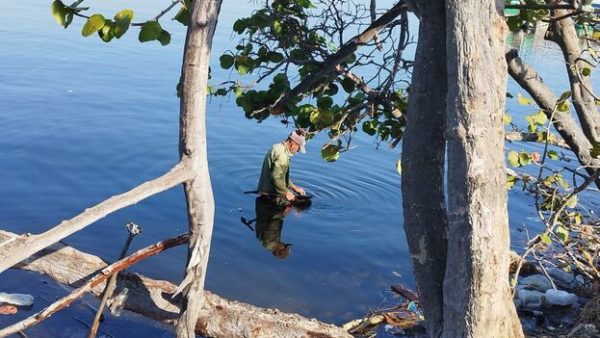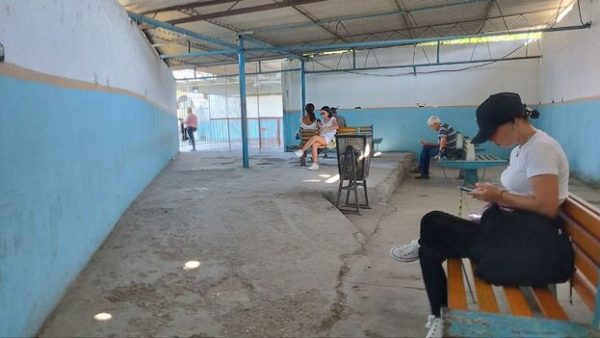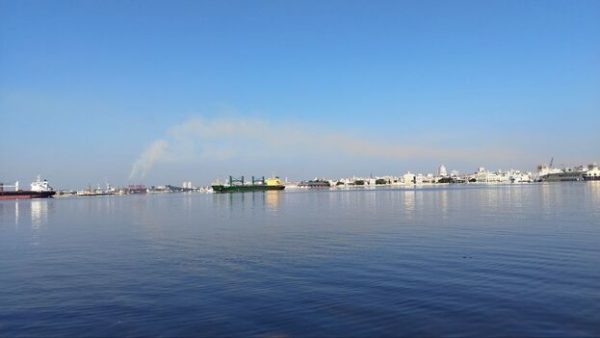Will the Boat that Crosses Havana Bay to Regla Survive?
A bridge in ruins and few passengers

The metal walkway leading to and from the boat is so rusty and full of holes that it is dangerous to overload it
By Natalia Lopez Moya/Juan Diego Rodriguez (14ymedio)
HAVANA TIMES – “Line up, one by one and slowly!” shouted a security employee at the Regla pier, to the passengers who had just arrived in the boat and had to travel over a short walkway to reach land. The metal structure is so rusty and full of gaps that it is dangerous to overload it.
Under the walkway, a man sunk up to his waist in the black waters of the bay dug into the mud in search of small crustaceans, perhaps to use them as fishing bait or to prepare a lunch. With each step that the travelers took on the bridge, there was a squeak, and the man tilted his head, as if foreseeing the collapse.
The deterioration of the walkway is just one of many things that, in recent years, make transit difficult between the Cuban capital and the town of Regla. The boat also shows signs of the passage of time and the lack of maintenance, in addition to having only one trip per hour, due to the fuel crisis that the country is going through.
“Sir!” the employee shouted, upset when she realized that one passenger tried to overtake another on the right side of the walkway. “You can’t do it like that,” added the woman, who said she was tired of the same thing “every day.” When the boat finished emptying, the scene was repeated, but this time with the new customers, who would disembark on the other side, in Old Havana.
A few meters from the damaged pier, on Friday morning a dozen inhabitants of Regla waved flags and shouted slogans for May Day, postponed last Monday due to weather conditions. The rally took place in front of Regla’s beautiful church and dissolved a while later without sorrow or glory.
In the nearby park, a group of people were waiting for a bus, and an old man talked about “the fight that happened on the bus,” an increasingly common scene given that the mood is very heated by the lack of transport. “It was tremendous, even the driver got hit,” added the man, staging the scene with his hands.
After the official May Day events and the uproar of the bus stop, Regla looked this morning looked like a paralyzed town, without the tourists who previously abounded in its streets or the avalanche of believers who visited its church to venerate the patron saint of the town and the Bay, which in santería is equivalent to the orisha Yemayá.

The panorama was also quite different from the turmoil that happened in Havana Bay three decades ago. Right at the jetty, from where the boat departs to reach Regla, the social explosion of August 5, 1994, known as the Maleconazo, began.
In a year when Cubans had hit rock bottom with the rigors of the Special Period, several attempts to hijack that boat stoked the hope of hundreds of people to “leave on the next boat for Miami.” With that illusion they gathered around the pier to try to board the boat and leave from a country where even a piece of bread had become a luxury.
When the police canceled the departures of the boat and closed the pier, popular indignation overturned on Malecón Avenue, with people breaking stained glass windows, overturning garbage containers and shouting anti-government slogans. In its three decades in power, the regime had never experienced such an event in the very streets of the capital.

ld Havana. (14ymedio)
In addition to the strong repressive response ordered by Fidel Castro, in August 1994 the opening of the borders was decreed, and more than 35,000 Cubans threw themselves into the sea in precarious boats. It was the so-called Crisis de los Balseros — The Rafter Crisis.
After the social protest, the Cuban regime militarized both piers and established strict security protocols on the docks of the two shores to prevent the hijacking of the boat. But with time and the lack of maintenance, the control measures have been relaxed, and the structures of the breakwater have been filled with rust.
A cluttered bridge, a few passengers who need to cross the bay and a boat that only leaves every hour is what is left. The shortage of fuel and laziness have done their part, but it has been the stagnation of Regla, its few options and its depressed trade, which have put the final point on mobility.
There is only one boat left to make the journey, every hour. The trip, although fast, gives an opportunity to contemplate the new element in the profile of the city, the Turkish floating power plant moored in the port of Havana, expelling polluting fumes.

Translated by Regina Anavy for Translating Cuba






Apart from hotels and jails and UNESCO sites, there is little in Cuba that is not, crumbling, rotting, rusting or collapsing.
That reflects the Communist Party of Cuba itself, which is barren of ability, initiative, ideas, economic knowledge and humanity!